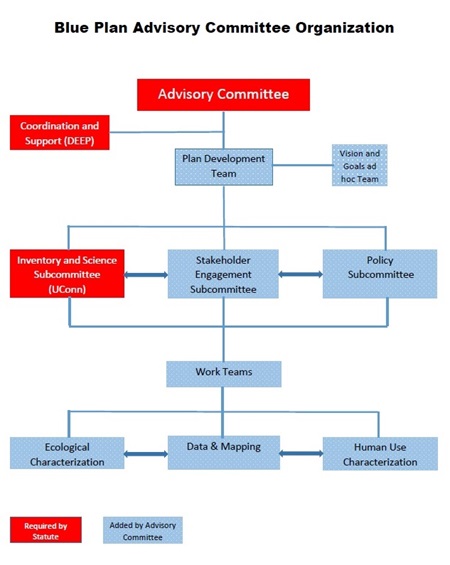The Blue Plan Process

A multi-stakeholder Blue Plan Advisory Committee (BPAC), which included representatives from water-dependent industry, universities, non-governmental organizations (NGOs), local governments, recreation and aquaculture interests, and others, pioneered the development of the Long Island Sound Blue Plan.

BPAC consisted of six Subcommittees and Work Teams, who conducted the work on the Blue Plan, and the Connecticut Department of Energy and Environmental Protection (DEEP), Connecticut Sea Grant, and The Nature Conservancy lead BPAC through the planning and development process. The work on the Blue Plan was grant funded and supported by existing staff resources from DEEP and other BPAC members; no special state funding was involved.
The Team engaged experts and stakeholders in the Blue Plan development and also held quarterly meetings open to the public in order to share information. The Team studied and adapted the planning process for the Blue Plan from other regions to effectuate a workflow matrix that involved public participation through each step.
 The first step of this process involved the collection and vetting of data on all of the natural resources and uses of Connecticut's Long Island Sound. This data was then compiled into an inventory of those resources and uses. The first iteration of the Blue Plan Resource and Use Inventory became available in March 2018. The Team then used the inventory to develop policies for resource preservation and use to maximize their sustainability and minimize conflicts. Key findings from the resource and use inventory and policy mechanisms were then combined to form the Long Island Sound Blue Plan. The process timeline concluded with the completion of the first draft of the Blue Plan in March 2019.
The first step of this process involved the collection and vetting of data on all of the natural resources and uses of Connecticut's Long Island Sound. This data was then compiled into an inventory of those resources and uses. The first iteration of the Blue Plan Resource and Use Inventory became available in March 2018. The Team then used the inventory to develop policies for resource preservation and use to maximize their sustainability and minimize conflicts. Key findings from the resource and use inventory and policy mechanisms were then combined to form the Long Island Sound Blue Plan. The process timeline concluded with the completion of the first draft of the Blue Plan in March 2019.
Subcommittee and Work Team Products
See wat the Subcommittees and Work Teams produced through the Blue Plan Process:
Blue Plan Vision and Goals June 14, 2017 Draft
Blue Plan Stakeholder Engagement Program July 5, 2017
Blue Plan Basics Factsheets
Blue Plan Frequently Asked Questions
Blue Plan Webinars and Map Books
Join the Long Island Sound Blue Plan Listserv to receive updates on web postings, the legislative review process, and other information.
Share your input on the Long Island Sound Blue Plan by completing and submitting the Blue Plan Comment Form or by sending an email to DEEP.BluePlanLIS@ct.gov.
Content Last Updated February 5, 2020

